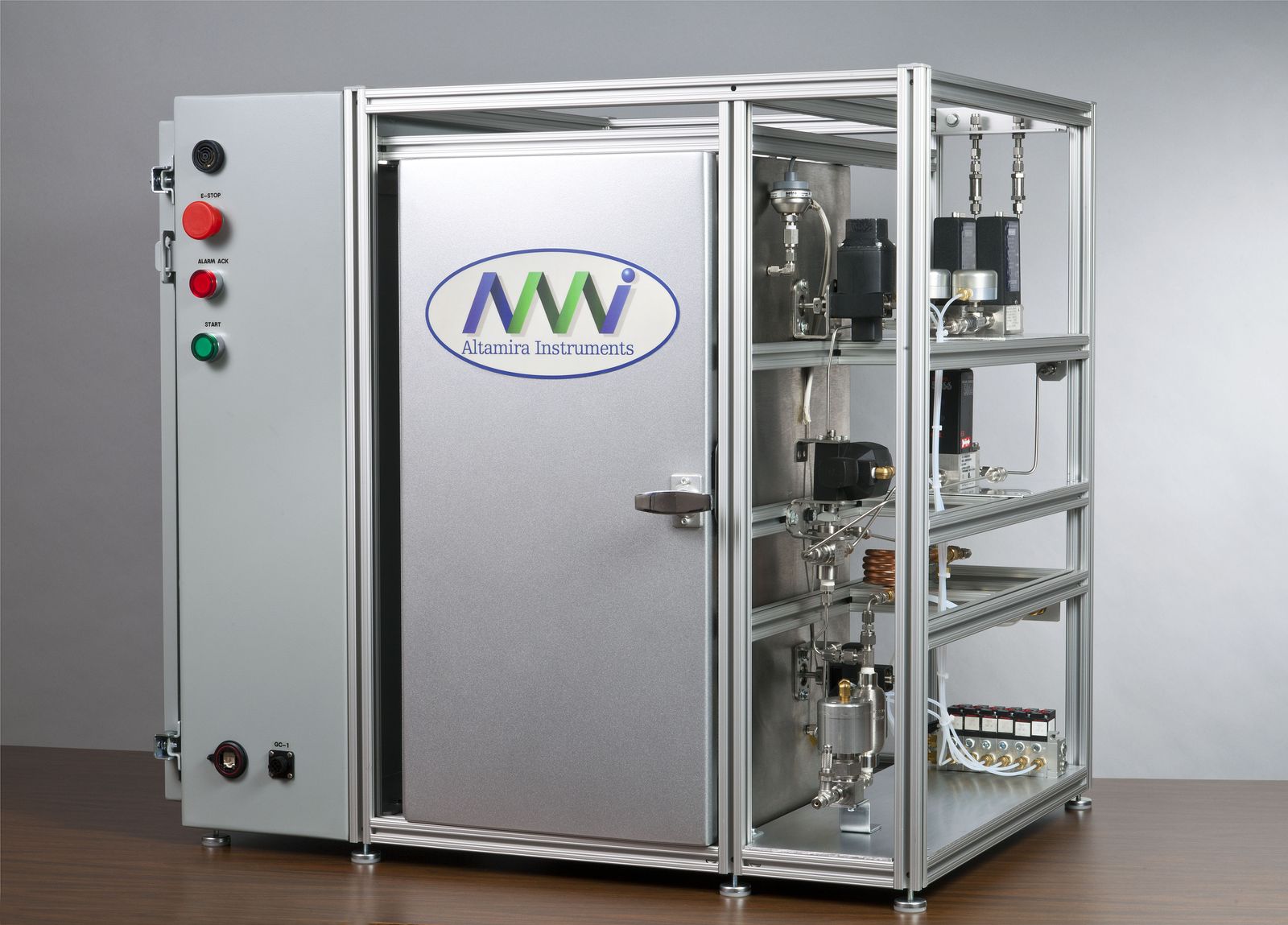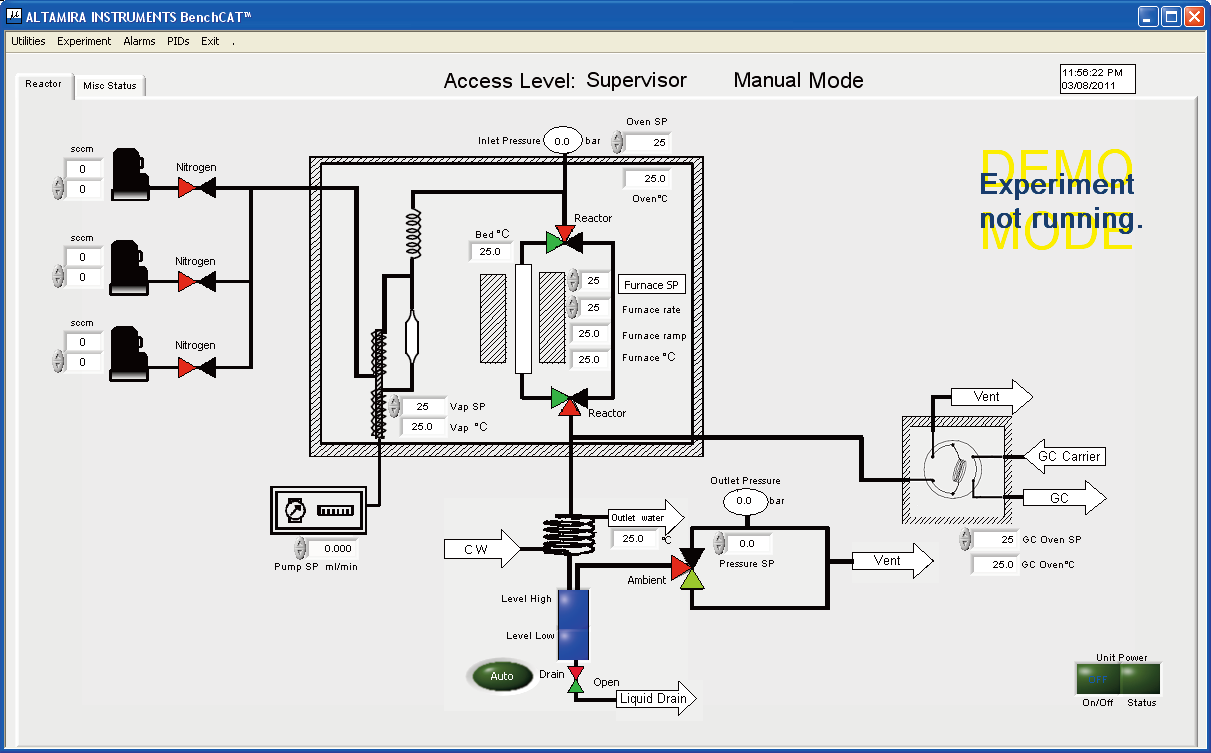The μBenchCAT by Altamira Instruments represents a complete, bench-top reactor for catalytic studies. All the components required for either gas-phase or liquid-phase reaction studies are contained in a fully automated compact package. A variety of options makes the μBenchCAT suitable for a wide range of studies.
BenchCAT
Bench-top Reactor for Catalytic Studies

System Features
| Maximum Operating Temperature: | 650°C or 1200°C, depending on reactor material |
| Maximum Operating Pressure: | Atmospheric, 30 bar, or 100 bar (higher pressures available) |
| Number of Gas Feeds: | Up to 6 |
| Number of Liquid Feeds: | 0, 1, or 2 |
| Reactor Material: | Stainless steel, quartz, or Incoloy |
| Wetted Materials Include: | Stainless Steel, PEEK, Kalrez, Viton, Incoloy, and Quartz |
| Isothermal oven housing most process components | |
| Full automation of process using LabVIEW | |
| Redundant safety thermocouples | |
| Slip-stream sampling (optional) |
Connection to External Detectors
The product effluent can be directed to an external detector, such as a gas chromatograph, via an optional heated or unheated sampling valve.
Hardware
Reactor Feed: Up to 6 gases and 2 liquids can be used in the standard configuration of the μBenchCAT. Each gas train incorporates a filter, electronic mass flow controller (MFC), check valve, and positive shut-off valve. The range and gas calibration of each MFC is specified by the customer. Liquids are delivered using high precision HPLC pumps.
Condenser: A tube-in-tube condenser is located outside the oven at the outlet of the reactor. A thermocouple is used to monitor the coolant return.
Gas/Liquid Separator: The gas/liquid separator is found downstream of the condenser. Two level switches (high and low) activate an automatic valve and serve to maintain level control.
Pressure Control: Exit pressure is measured with a separate pressure transducer and the pressure is controlled using an automatic tapered needle valve.
Product Sampling Valve: An optional product sampling valve can be used to route an effluent sample to an external analytical device.
Heated Oven: Most process components are housed inside an isothermal oven operated at up to 200°C.
The following components are found in the heated oven:
• Integral gas preheater and liquid preheater/vaporizer operating at up to 300°C
• Feed mixer
• Reactor by-pass valves
• Reactor furnace with measuring and safety-switch thermocouples
• Reactor with internal thermocouple
• Pressure transducer isolator
• Lines leading to pressure transducer and pressure relief valve
mounted outside the oven.
Computer Control
The μBenchCAT is fully automated for ease of operation and reliability. It is designed so that it can be run unattended. The operator simply inputs process parameters as a series of steps and schedules a start time. Valve positions, flow rates, temperatures, pressures, and product sampling are controlled by the operating software. Data readback of the process are monitored at a rate specified by the user. The data are saved in a text-delimited format for easy transfer to other programs.
The control and data acquisition are performed using a LabVIEW application software specifically written for the μBenchCAT. Complete experiments can be written in minutes and saved for future use.

Safety
A number of safety features are built into every μBenchCAT. These include:
- Check valves in all gas and liquid feed lines to prevent backflow
- Software-coded alarms that monitor temperatures and pressure for possible excursions. These alarms are based on the equipment safety limitations, and are configured by Altamira Instruments
- User-defined alarm matrix where the user can specify lower and upper limits of process parameters and what actions to take in the event that these limits are reached
- Hardware over-temperature limit switch for the furnace
- Firmware-level alarms on all heaters
- Preset relief valves to prevent over-pressurization
- Power switch mounted on the front of the instrument to control power output to the instrument in case of an emergency
- Double fusing in all 220 VAC process equipment





